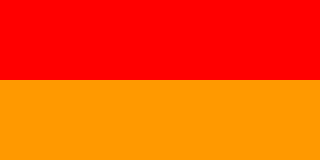
The Rajputana Agency was a political office of the British Indian Empire dealing with a collection of native states in Rajputana, under the political charge of an Agent reporting directly to the Governor-General of India and residing at Mount Abu in the Aravalli Range. The total area of the states falling within the Rajputana Agency was 127,541 square miles (330,330 km2), with eighteen states and two estates or chiefships.

Vasundhara Raje Scindia is an Indian politician, who has held two terms as the chief minister of Rajasthan. She was previously a minister in the Union Cabinet of Atal Bihari Vajpayee and was India's first Minister of Small Scale Industries and Agro and Rural Industries, which now known as Micro, Small and Medium Enterprises. In 2003, she became the first woman to serve as the Chief Minister for the state of Rajasthan. She is currently one of the national vice presidents of the Bharatiya Janata Party (BJP). A member of the Scindia family, she is also the matriarch of the Bamraulia family of Dholpur.

Chhatri are semi-open, elevated, dome-shaped pavilions used as an element in Indo-Islamic architecture and Indian architecture. They are most commonly square, octagonal, and round. Originating as a canopy above tombs, they largely serve as decorative elements as opposed to functional elements. The earliest examples of chhatri being used in the Indian Subcontinent were found in the Shrine of Ibrahim in Bhadreswar, constructed between 1159 and 1175 AD.
Dholpur is a city in the Dholpur district in Rajasthan state of India. It is situated on the left bank of the famous Chambal river. The city is the administrative headquarters of Dholpur District and was formerly seat of the Dholpur princely State of Jats.

Jivajirao Scindia KStJ was the ruler of an Indian vassal state during the British Raj and later a government official.

Kirat Singh Rana (1763–1835) was a Jat ruler of Gohad state (1803–1805) in Madhya Pradesh, India. He was the founder and first ruler (1805–1835) of Dholpur princely state.
Rana Pohap Singh was the Jat ruler of Dholpur state in (1836) in Rajasthan, India. He was from Bamraulia gotra of Jats. He was the elder son and successor of Rana Kirat Singh. He ruled for nine months and died in 1836. After his death his younger brother Rana Bhagwant Singh ascended to the throne.

Nihal Singh CB was the Maharaj-Rana of f Dholpur state from 1873 until his death in 1901.
Sir Ram Singh KCIE was the Maharaj-Rana of Dholpur from 1901 until his death in 1911.

Sir Udai Bhan Singh was the Maharaj-Rana of Dholpur from 1911 until his death in 1954.

Dushyant Singh is an Indian politician businessman and member of the former ruling family of Dholpur state, presently serving as the Member of Parliament for Jhalawar-Baran in the Lok Sabha. He has been elected to four terms and is a member of the Bharatiya Janata Party.

Yashodhara Raje Scindia is an Indian politician and Minister of Sports and Youth Welfare, Technical Education and Skill Development and Employment of Madhya Pradesh. She is also the former Minister for Commerce, Industries and Employment in Government of Madhya Pradesh. She is the youngest daughter of Jivajirao Scindia, Maratha Maharaja of Gwalior and the Late Rajmata Vijayaraje Scindia of Gwalior. She was first elected from Gwalior to the 14th Lok Sabha via a by-poll in 2007 and again in 2009 General Election. She is a Member of Legislative Assembly from Shivpuri constituency in Madhya Pradesh since 2013.

The history of human settlement in the western Indian state of Rajasthan dates back to about 100,000 years ago. Around 5000 to 2000 BCE many regions of Rajasthan belonged as the site of the Indus Valley Civilization. Kalibangan is the main Indus site of Rajasthan, here fire altars have been discovered, similar to those found at Lothal.
Maharaj Rana Hemant Singh was the Rana of Dholpur from 1954–71, when all royal titles and privy purses were abolished by Republic of India.

Bharatpur State, which is also known as the Jat State of Bharatpur historically known as the Kingdom of Bharatpur, was a Hindu Kingdom in the northern part of the Indian subcontinent. It was ruled by the Sinsinwar clan of the Hindu Jats. At the time of reign of king Suraj Mal (1755–1763) revenue of the state was 17,500,000 rupees per annual. The major architecture of this state include Lohagarh Fort and Deeg Palace.

Bikaner State was a princely state in the Rajputana from 1465 to 1947. The founder of the state, Rao Bika, was the eldest son of Rao Jodha, ruler of Jodhpur. Rao Bika chose to build his own kingdom instead of inheriting his father's. Bika defeated the Jat clans of Jangladesh along with his uncle Rao Kandhal and his adviser Vikramji Rajpurohit and founded his own kingdom. Its capital was the city of Bikaner in the northern area of present-day Rajasthan State in India. Karni Mata has been designated as the kuldevi of the royal family of Bikaner.

Gohad State or Kingdom of Gohad was a Jat kingdom in India. It was established by Jat King Singhadev II in 1505. The state was ruled by Jats.
Bhagwant Singh was the Maharaj-Rana of Dholpur from 1836 until his death in 1873.


















